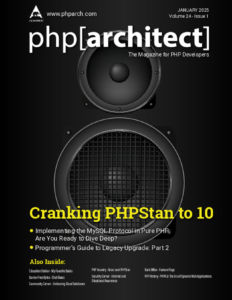Several jobs ago, when we realized that we needed a new database server, it was a complicated process. We had to write up a lengthy explanation about why we needed the new server along with some estimates on storage growth and usage over the lifetime of the server (which, if we’re honest, were all guesses, and I’m glad nobody called me on them). by Scott Keck-Warren
Improving code quality requires pushing boundaries. This month, while working on the Spacetraders quick start tasks, I pushed PHPStan to its limits. Each progressively stricter static analysis level had some challenges hand-in-hand with clear benefits. What’s the goal? I want to leave behind the “safe” comfort of level 5 and take it to the newly added level 10. Along the way, I learned the nuances of type-hinting arrays, handling generics, and dealing with mixed types. Read on to see what I learned and how you can use it in your own projects. by Oscar Merida
The release of PHP4 in May 2000 marked a significant milestone in the evolution of web development. This new version of PHP brought with it a host of innovative features and improvements that would shape the future of dynamic web applications. In this comprehensive exploration, we’ll delve into the key innovations introduced by PHP4 and examine their lasting influence on the web development landscape. by Christopher Miller
Feature flags are useful. However, they add to code complexity and, when over-used, can create a mess. by Edward Barnard
It may shock some of you who read these articles to find out that I have been writing software in various degrees for nearly twenty-five years. I know that realization is still shocking to me, especially since the COVID lockdown has ruined my sense of time. Software development has always been a passion of mine since I started messing around with the Tandy Color Computer 2 we had with the busted cartridge socket. To think that I managed to turn that into a career is somewhat mind-boggling. by Chris Tankersley
A YouTube short, (https://www.youtube.com/shorts/4Kq30C0pB1s), I recently came across featured a well-known developer explaining that “any network I am not currently the administrator of is a PvP enabled network.” This advice caught me off guard at the time as I subscribe to his feed for gaming and software development information, not necessarily security. However, his description is a solid way to think about internet security with mobile devices. by Eric Mann
In my last article, I mentioned my experience with a chat box on the LinkedIn website and how I was less than impressed. I just expected more from a huge company like Linked In, which has a strong reputation for caring about accessibility. So, I wanted to share some thoughts on chat boxes and give some advice on how to avoid creating problems for your business or one of your clients. by Maxwell Ivey
Last month we covered the getting your mindset right for tackling a legacy upgrade. Let’s do the fun part now and dive into the technical details. Please read last month’s issue for Part 1. by Tomáš Votruba
The MySQL protocol underpins seamless communication between applications and databases, yet its inner workings often remain hidden behind libraries like PDO or MySQLi. This article embarks on a journey to implement the MySQL protocol in pure PHP, offering an in-depth look at packet structures, authentication flows, and query execution. Whether for learning, innovation, or debugging, this exploration reveals the unseen architecture powering MySQL/MariaDB. by Bohuslav Šimek




Leave a comment
Use the form below to leave a comment: